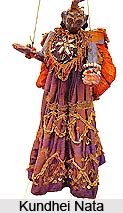 Kundhei Nata is one of the ancient folk art forms in India. Also called Gopa Lila, it is basically a traditional glove or hand puppetry. Kundhei Nata is mainly practiced in the Odisha state of India. It is performed by a two member troupe where one manipulates the puppets while the other acts as narrator, singer, and drum-player. Kundhei Nata exhibits love story of Lord Krishna and Radha. Made of wood and paper, the puppets are usually attired in long skirts, as is the tradition in Indian puppetry.
Kundhei Nata is one of the ancient folk art forms in India. Also called Gopa Lila, it is basically a traditional glove or hand puppetry. Kundhei Nata is mainly practiced in the Odisha state of India. It is performed by a two member troupe where one manipulates the puppets while the other acts as narrator, singer, and drum-player. Kundhei Nata exhibits love story of Lord Krishna and Radha. Made of wood and paper, the puppets are usually attired in long skirts, as is the tradition in Indian puppetry.
Themes of Kundhei Nata
The show of Kundhei Nata uses only two figures representing Krishna and his love Radha, nowadays so humanized that at times they act like any rural boy and girl. In the twelfth century, when the poet Jayadeva wrote the Gita Govinda, the Krishna-Radha theme grew extremely popular in Odisha for dramatic presentation. Krishna worship became more and more extensive and reached its peak in the sixteenth century when it influenced not only theatre but also all branches of art and literature. During this period, it is likely that both glove and string puppet traditions of Odisha adopted Krishna legends as their exclusive thematic content. Many lyrics, short poems, and long narrative verse or kaiya written between the sixteenth and nineteenth centuries were inspired by Krishna. Others had human heroes and heroines. The glove puppeteers use these poems, mainly devotional but sometimes secular.
Performance of Kundhei Nata
Kundhei Nata comprises only two persons, the lead puppeteer and a drummer-cum-puppeteer. They require no stage to present their performance neither do they hide behind a screen. They sit on a mat or level ground and manipulate the puppets in full view of the audience. At times, the drummer who plays the barrel-shaped dholak holds one of the two puppets. While manipulating the figure, he occasionally beats one face of the drum with the hand that wears the puppet. It appears as if the puppet is playing the drum. This act immensely amuses viewers. There is not much drama in a Kundhei Nata show, nor is the technique in any way complicated though, at times, it is quite imaginative. Its main attraction lies in the singing and the literary quality of the songs. Interspersed humorous sequences enhance the appeal. Singing is the main attraction of Kundhei Nata that inculcates humour. Kuratti, Kuravan (a tribal man), and Muttiyamma (grandmother) are the main characters of the play. In Kundhei Nata men enact the roles of women.
The instrumentalists and vocalists who were also a part of the play take their position in the rear. They are usually seen playing instruments like mridangam, drums and kaimani (small cymbals). They inaugurate the play by singing hymns in praise of Lord Ganesha and Goddess Saraswati. After their performances two Kurattis make their entrance and assume the roles of spouses of Lord Vishnu and Lord Shiva. They then enact various gestures of wordy fights through different forms of singing and dancing. During their arguments they find fault with each other`s husbands. In the concluding session a third Kuratti pretending to be Goddess Saraswati approaches for their rescue and then makes a comprises between the earlier two Kuratti. Later a Kuravan makes his entrance and displays many acrobatic acts that include rope dancing and musical plays. As a final act his old mother dances thus providing wholesome entertainment to the audience.




















